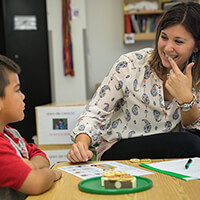Summary of Words to Use and Words to Lose
Consider keeping this summary handy as a reference guide whenever you are preparing to share a story about Head Start or tell someone about our mission.

“Head Start staff have been really interested and quite receptive to the ideas shared. They have been able to quickly identify ways they can incorporate these recommendations into their daily communications about Head Start, and have been enthusiastic about returning home and making positive changes.”
–James Anderson, Family Resource Agency, Inc.,
Georgia and Tennessee
Our mission, in a nutshell:
Defines who we help using words that inspire action: when children are at risk, we are called to support them.
Signals that we’re delivering results: after participating in Head Start, children leave with critical skills.
Shows we’re helping prepare Head Start children for kindergarten and beyond.
Speaks to our comprehensive model
Sums up our mission in visual, vivid language
Keywords To Use And Lose
| Instead of saying this... | Say this... |
|---|---|
We’re here to lead you / inform you / offer you resources |
We’re here to partner with you |
Low-income families |
Income-eligible families |
Leveling the playing field |
Supporting more children, families, and communities on their path to success |
Social justice |
Every child deserves an opportunity to succeed |
Head Start is a free program. Head Start is federally funded. |
Head Start is an investment that helps all students be ready for school |
Innovative laboratories |
Head Start is at our best when we apply an always-learning mindset |
No matter where Head Start programs operate, they all meet our national standards |
Head Start programs ensure children receive vision, hearing, and other health screenings and referrals; require degrees and credentials for teaching staff; and mandate professional development and coaching for lead and assistant teachers |
Head Start children reduce their vocabulary deficit by 38% during the program year |
Head Start students are more likely to graduate high school, attend college, and receive a post-secondary degree, license, or certification |
